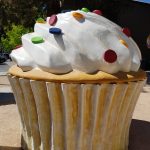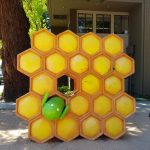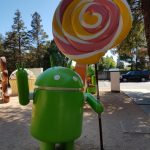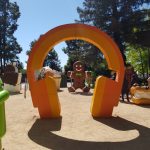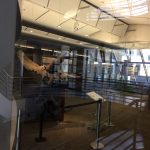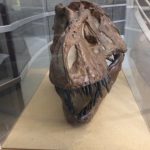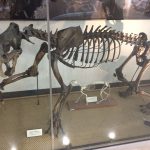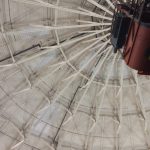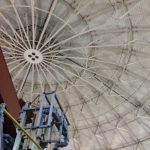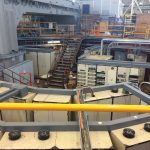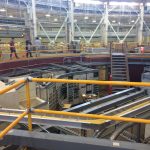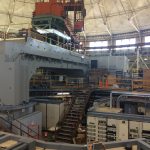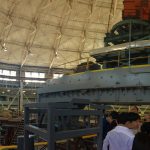There was an article written in Bloomberg on 31 May 2022 by Katie Linsell (https://www.bloomberg.com/news/articles/2022-05-31/why-is-my-ice-cream-shrinking-inflation-by-stealth-quicktake) which talked about shrinkflation. This word is an amalgamation of the words ‘shrink’ and ‘inflation’. Inflation is the effect of things getting more expensive over time. Shrinking is things getting smaller. By putting the two words together, we are talking about the effect of things getting more expensive by having things come in smaller packages but being sold for the same price, effectively increasing the per unit cost of something.
Continue ReadingCategory: Blog
Israel Credit Ratings on Review for Downgrade
There was an article in The Straits Times on 21 October about how Moody’s is reviewing the Israeli government’s credit ratings, possibly for a downgrade. Israel and Hamas are currently engaged in a conflict.
Before we go into further details, let’s answer the question of what is Moody’s, and what are credit ratings?
- Moody’s is a ratings agency which gives a score to how reliable a borrower is; in other words, how likely a borrower will repay its debts.
- The scores rating agencies assign are known as credit ratings.
This move by Moody’s is not surprising, since when a country is involved in war and conflict, more of their resources will be diverted to the war effort, affecting their ability to repay any debts on time.
Continue readingBond Yields Rising
There has been a lot of talk recently about bond yields rising. This usually happens when central banks decide to raise interest rates. Let’s examine how interest rates affect bond yields. Some concepts that will be used in this analysis:
- Risk-free rate of return: A theoretical rate of return on an investment which carries 0 risk. Does not actually exist because every investment has some risk.
- Bond: A financial instrument that pays investors a regular, fixed amount of money as interest
- Bond yield: The regular payment of the bond interest divided by its price.
Cheat notes: When rates increase, bond yields will rise as bond prices drop. The opposite situation is also true.
Continue reading “Bond Yields Rising”2018 USA Summer Camp – Day 4
This was the students’ last day on the campus of the University of California, Berkeley, and in some ways, it would be their most important day here. For the morning, we were being hosted by the Admissions Department of the university, so this would be the perfect chance for all future Cal Bears to ask any questions they have about the admissions process, be it to do with testing requirements, application deadlines, or even about life on campus.
The students found the session very informative, with the admissions officer dispelling many myths about the admissions process and requirements from students. It also got a lot of students thinking about what they had to do on their academic journey if they wanted to come study in the United States at some point in the future. It was a nice coincidence that the teacher-in-charge from Hwa Chong International was also in charge of admissions, so she also found the session useful and informative.
Our last on-campus stop was to go up Sather Tower to its observation deck. Once there, we got a close-up view of the carillon, and it just so happened that there was a graduation ceremony going on that day, so we got a bird’s eye view of the celebrations:

And here’s the view you will see when you get to the top of Sather Tower:
And that was one of the very last things that the students from Hwa Chong International School were going to see of Berkeley for a while, at least until their next visit. One quick lunch later, and we were off to one of the highlights of our trip: the visit to Google Headquarters in Mountain View.
The visit to Google is something that is always requested by our participants, and thanks to the generosity of a few friends working there, is something that we have always been able to accommodate. As always, the first stop is the Visitor’s Centre, where they can view the Wall of Meng. This stop is always exciting to our Singapore participants, because Tan Chade-Meng (who the wall is named after) was the first Singaporean hired by Google. It’s doubly exciting for this group of students because Tan Chade-Meng is also an alumni of Hwa Chong Institution.
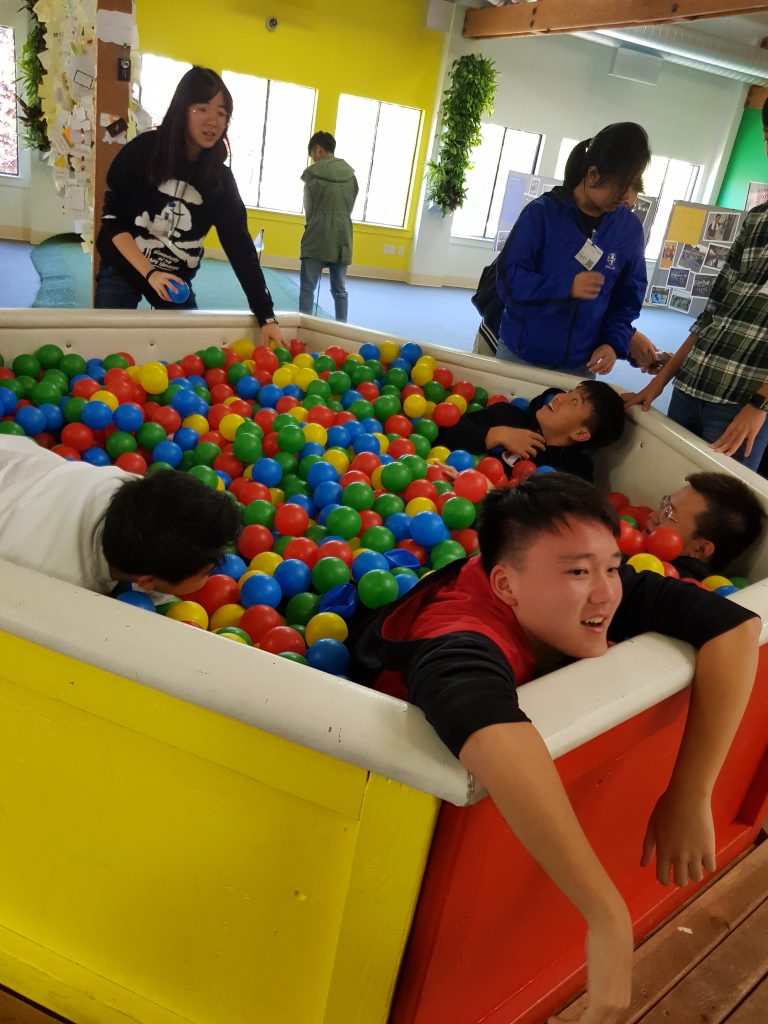
Following on the theme of relaxation, our next stop was the staff recreation area. Here, you can find retro pinball machines, foosball tables and of course, the famous free drinks and snacks which we were allowed to partake in.

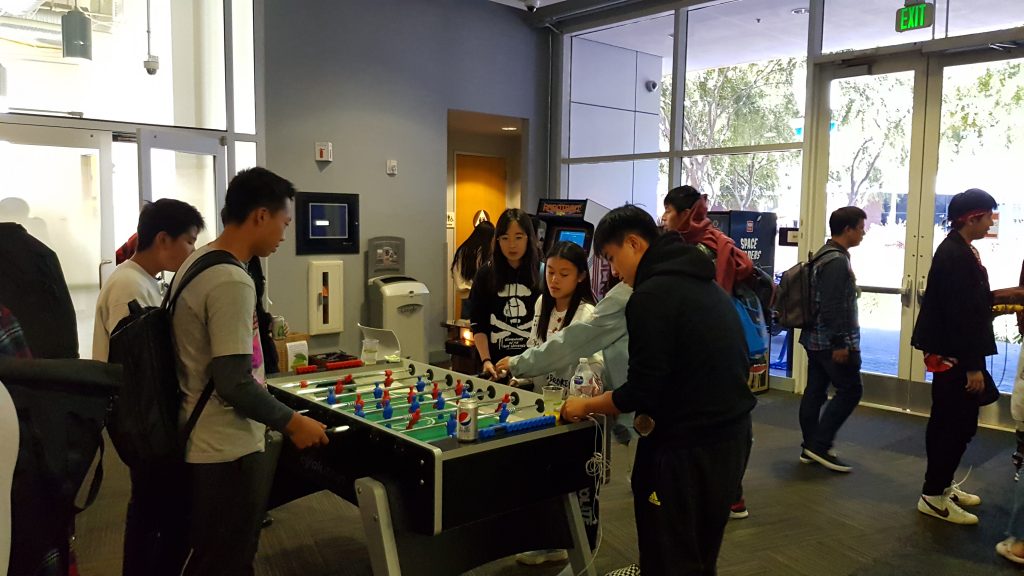
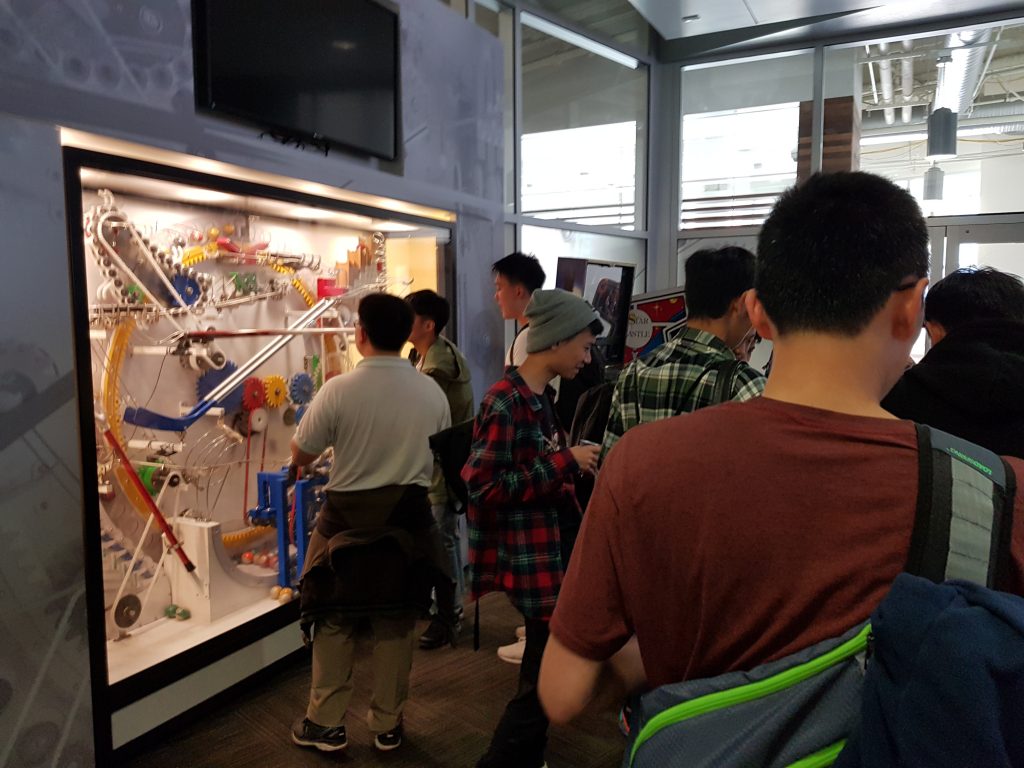
We also viewed the main buildings where all the hard work happens, and we just had to take our group photo in front of the building which bore the Google logo (just so we could tell all our friends that we really went to Google):
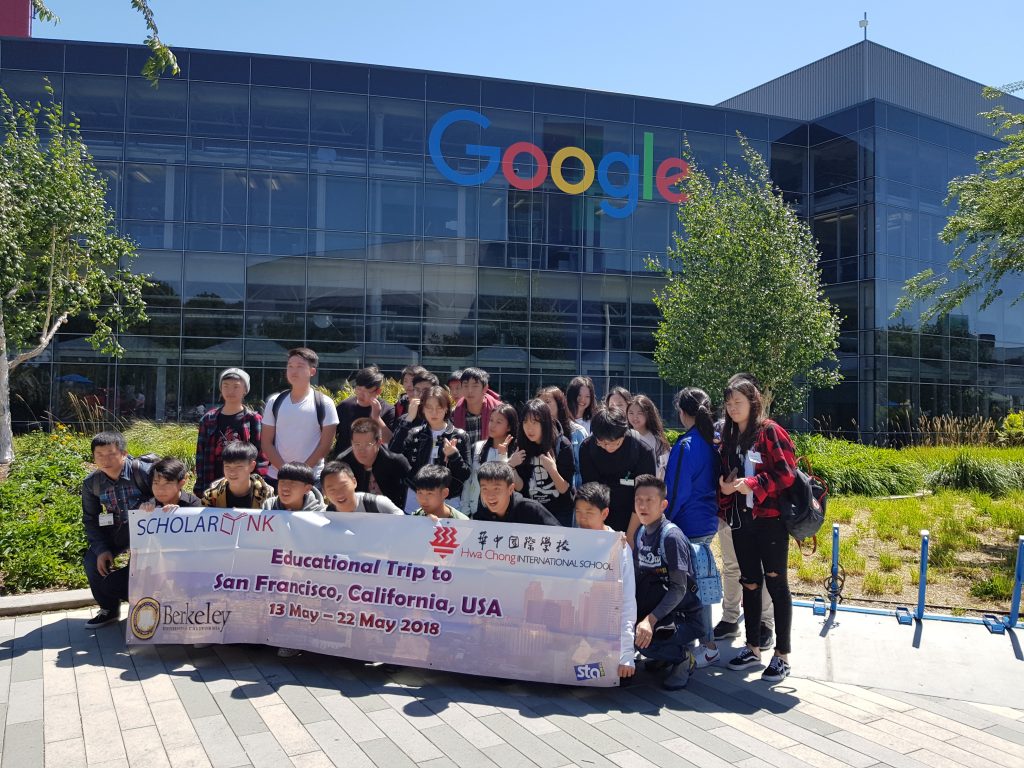
Finally, our two gracious hosts sat all of us down and took any and all questions in a Q&A session.
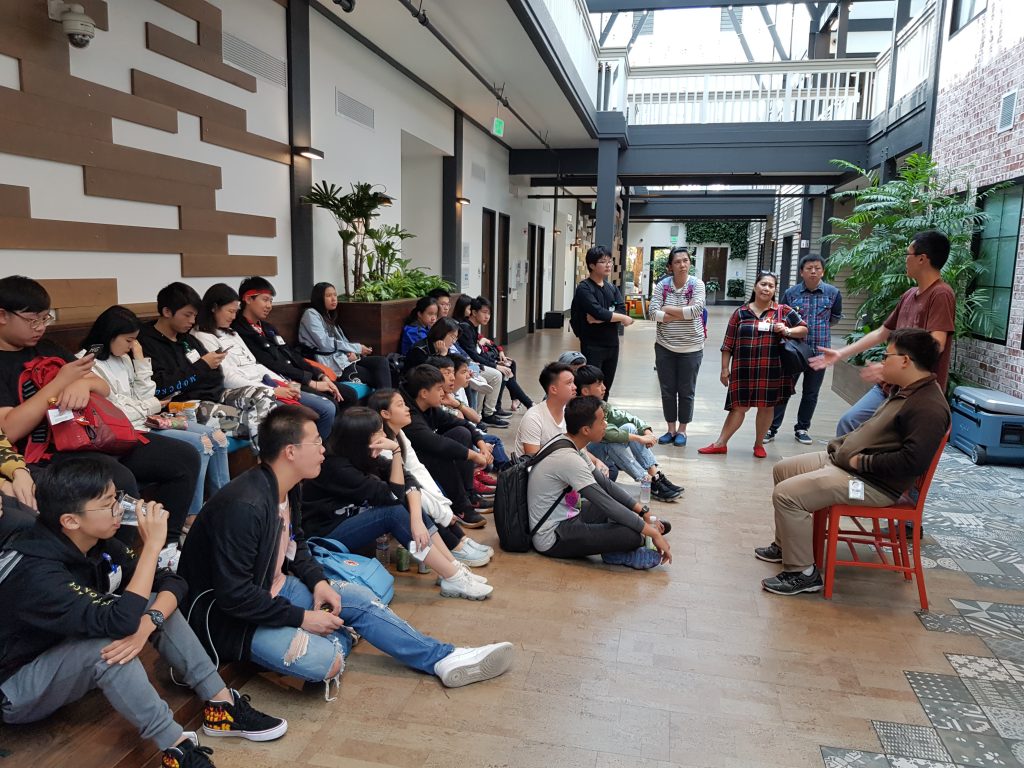
Many of the questions were centered around how they got their jobs at Google, what did they study in college in order to get their current jobs and what students should do now in order to increase their chances of getting a job there. Suffice to say that everyone was suitably impressed with Google and wanted to get a foot in the door.
One of the interesting things at Google which the students did not the the chance to see (due to us running out of time) was the Android garden. Here, you can find statues representing each version of the Android OS that has come and gone, in perfect alphabetical order. Can you name them all?
2018 USA Summer Camp – Day 3
The third day of our USA Summer Camp would also feature our last Bioengineering workshop. For this day, we decided to take things easy, and it would mainly feature the graduate student group giving us a series of lectures, as well as a seminar from one of the bioengineering professors, Terry Johnson.
Of all the lectures delivered that day, I think the one that the students enjoyed most was one from a graduate student named Daniel. He works with Professor Daniel Fletcher, and the project he was working on was a smartphone attachment that could turn your smartphone camera into a laboratory grade microscope. The students enjoyed the talk because (a) all of them already had a smartphone, and so this was something they were familiar with, (b) they hoped that one day they could buy this device and do some really nifty stuff with their phones. Dan was also kind enough to bring a few prototypes along, so after his demonstration, several of the students could also have a go with the lens attachment on their own smartphones.
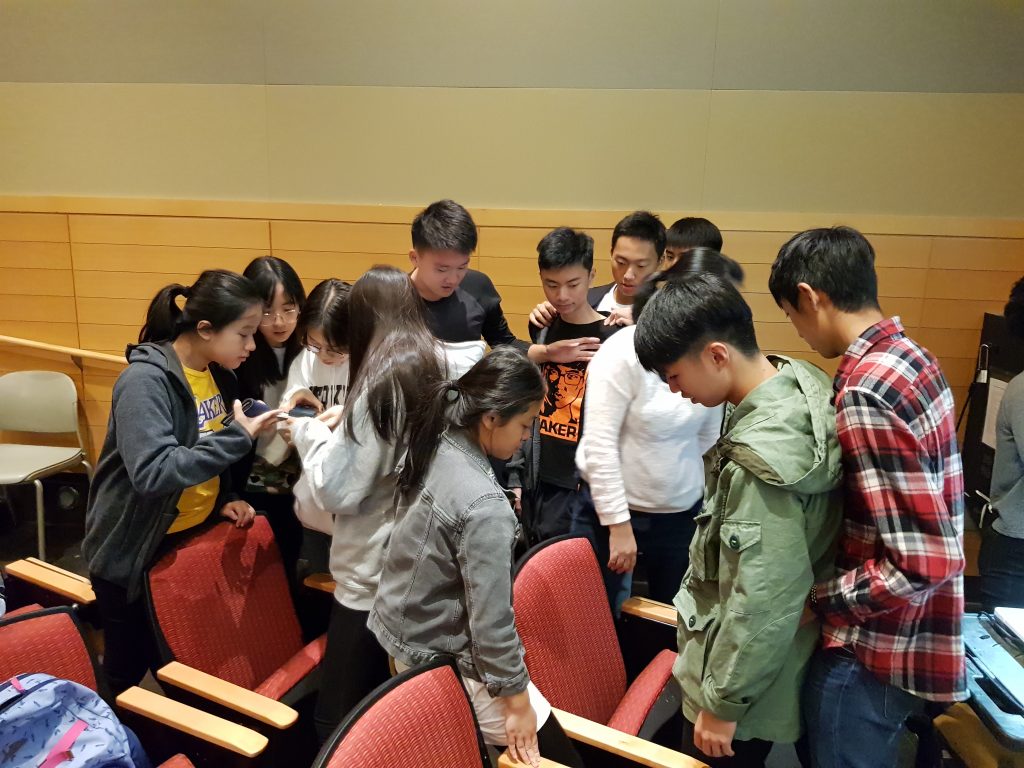
All in, this workshop showed them that bioengineering has many uses in our everyday lives, and is not something confined to research laboratories and highly academic research. The students concluded their time at Berkeley with some basic knowledge of what bioengineering is all about, what are some of the research projects that graduate students engage in, how a bioengineering lab looks like and what are some of the applications in real life.
After lunch, we brought the students to visit two of the most iconic attractions at the university which are also frequented by members of the public. The first is the Berkeley Art Museum & Pacific Film Archive, which is the visual arts center of the University of California, Berkeley. There, the students had the opportunity to browse through the various art exhibitions, and of course, some of them made a pit stop at the store to pick up souvenirs.
Our last stop of the day was to the UC Botanical Gardens. The Botanical Gardens is a 34-acre piece of land home to over 10,000 types of plants including many rare and endangered species. The Garden is organized geographically, and features 9 regions of plantings from Italy to South Africa, and a huge collection of plants native to California. Plants from all the continents on Earth can be found here.
We had arranged for guides for our students, and we were lucky to have a number of them available that day, do we could break the students up into smaller groups. As this was a science-based visit, the guides were to show the students how math is present all around us, even in the plants that we often take for granted. For example, the centers of many flowers grow in precise geometric patterns, and similarly for leaves of certain plants as well. The gardens even had a greenhouse, and it was a strange and familiar feeling to travel all the way to California to see some of the plants that we are so used to seeing here in Singapore, such as bananas.
I think everyone appreciated the chance to get some sunshine and to stretch their legs, but after a couple of hours, it was time for them to get back to the hotel and get packing, because tomorrow would be their last day in Berkeley before they embarked on the other parts of their visit to the great state of California.
2018 USA Summer Camp – Day 2
The second day of the program once again started with a bioengineering workshop, this time conducted by the undergraduate honors society for bioengineering. Kevin Godines was our host, and his interest was in the anatomy of biological organisms. I think the students had the most fun with his activity: he had us examine our hands as tools used to grasp objects, and then, providing us with nothing but some string, straws and tape, challenged us to build something that would be capable of grabbing a paper ball and depositing it into the trash can. We could do anything we wanted with the materials provided, so it was really interesting to see what the students came up with. There were those who went with very complex designs that they hoped would give a firm grip, and there were those who went for simplicity, but that also meant that the paper ball was held quite precariously and a good sense of balance was a prerequisite to completing the challenge.

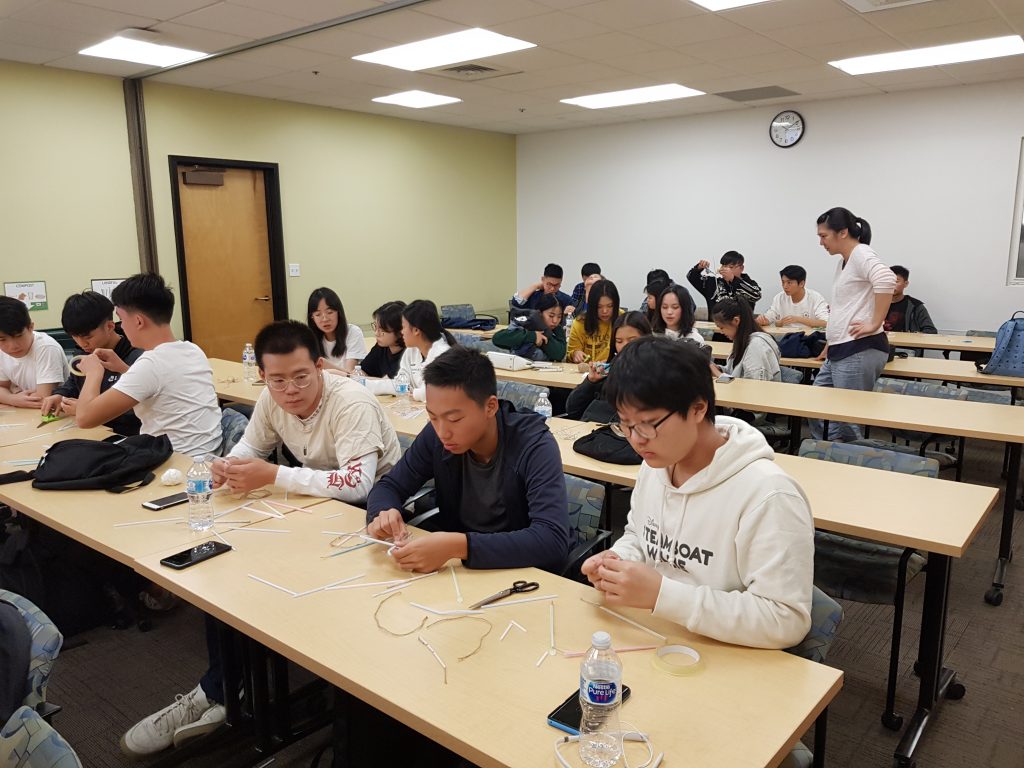
I knew this was a very engaging activity when I saw the accompanying teachers taking part as well. In fact, the simplest design which used just two straws (something simulating our hand would require at least 4 straws) was done by Ms. Michelle Koh, who was the teacher-in-charge for this group of students. Here’s her award-winning design in action:
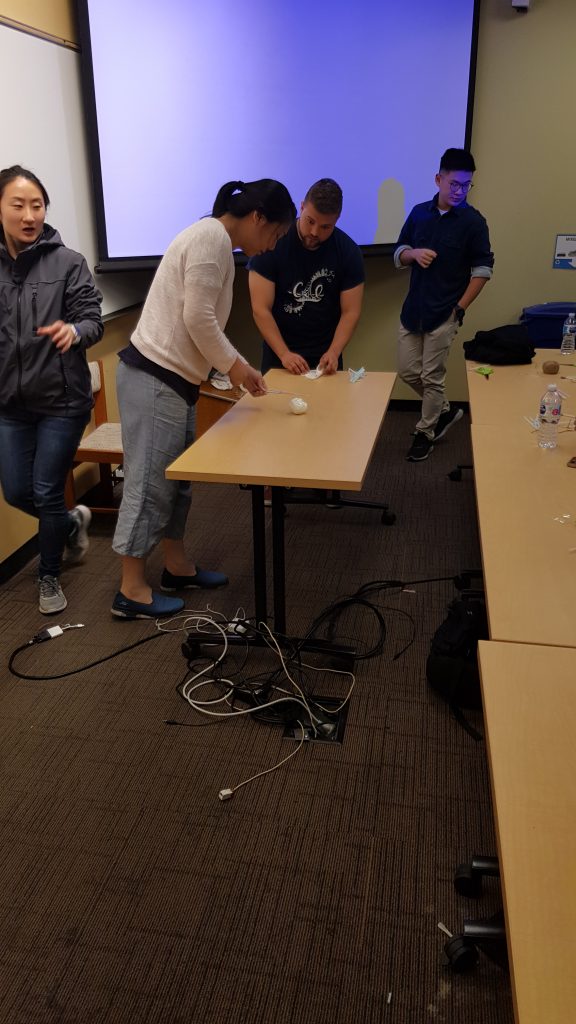
Through this hands-on activity, the students got a better appreciation for the design of our body, as they realized that even just to do something as simple as pick up a paper ball, there is a lot going on in our hands, and that our hands themselves are a marvel of design, with many more intricate moving parts than they had previously realized.
After the workshop and giving the students to fill their tanks during the lunch break, we headed over to Telegraph Avenue. Telegraph Avenue is one of the main roads leading to the university campus, and is one of the most popular spots for students. There are a number of eating places to be found here, and several stores which sell all the gear that a UC Berkeley student would need for their academic studies. But of course, these same stores also carry a lot of university-branded merchandise, and these made wonderful souvenirs for the students to bring home with them to remind them of their time at Berkeley.
After gathering everyone back from the shops, we embarked on another student tradition: hiking up the Big C. The Big C is a concrete letter C that is built into the hills overlooking the Berkeley campus. During the week leading up to the big football game with UC Berkeley’s rival, Stanford, students from the university are tasked with protecting it and ensuring that it doesn’t get vandalized, mostly by Stanford students seeking to paint over its yellow paint (Berkeley’s school colors) with red (Stanford’s school colors). This was a great chance for the students to get up close and personal with the nature that is literally in the university’s backyard:
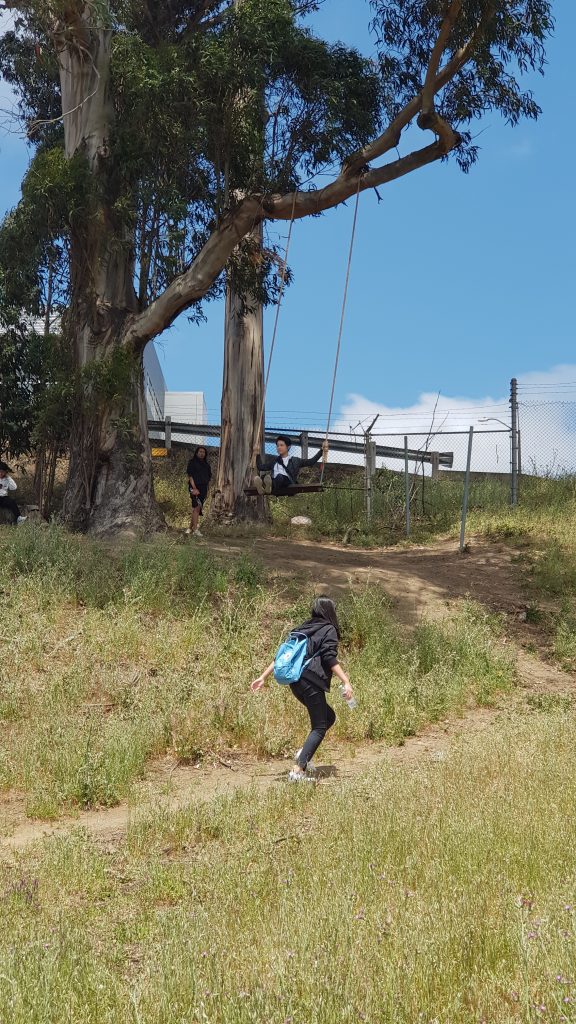
Right at the top of the hill, we found the swing that was previously lower down the hill. Some enterprising student had moved it up to a higher vantage point and even reinforced it. Typical of students from one of the top engineering schools in the world. Although it looked sturdy enough, the swing would swing you out over a sheer slope, so not everyone was brave enough to venture a go on it:
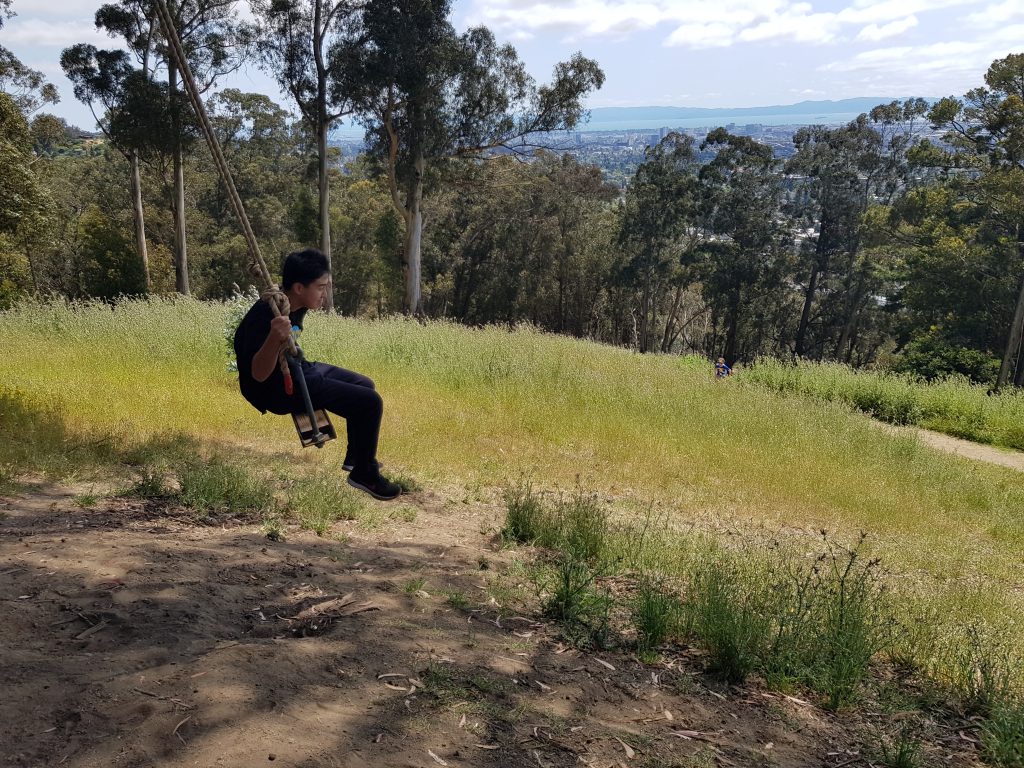
But one thing that everyone did enjoy was the fantastic view of the East Bay, the university campus and the city of San Francisco. After this rather tiring hike, it was an easy stroll back down and on towards dinner!
2018 USA Summer Camp – Day 1
Another year, another round of summer camps! This time, we were once again working with Hwa Chong International School to bring their students for the UC Berkeley Experience. Based on the positive feedback from other students who have been on the program, we had a record number of students attending this year – 27 in all. Just like in 2017, it would be a short program of just one week at the university, followed by some sightseeing and visiting of other tourist attractions in the Bay Area. And just like last year, the academic portion of our USA Summer Camp, as requested by the school, would focus on bioengineering.
We hit the ground running, with the bioengineering workshop being the very first activity for the students upon their arrival on campus. As it was the graduate student group that played host to us on the first day, the students were exposed to some quite interesting activities. First off, they were treated to a tour of some of the bioengineering labs at the university. The students were shown first hand some of the work that the graduate students were doing, as well as the experiments that were being conducted. Whenever possible, the students were also invited to have a go with the equipment to give them some hands-on experience. This was a really cool outing for the students, because they got to see some cutting edge equipment, and also to see what are some of the things they could be doing at the university level if they ever chose to venture down this academic path.
After all the touring, it was time to get their hands dirty, and the graduate students led us in a simple experiment that put us all close in touch with the building blocks of our human biology – extracting DNA, not from a human, but from strawberries. We learned that strawberries are used for this experiment because they are an excellent source for extracting DNA: easy to pulverize, and they have eight copies of each chromosome so there is a lot of DNA to isolate.
I won’t go into the details of the process, but here’s an example of what students got from this experiment:
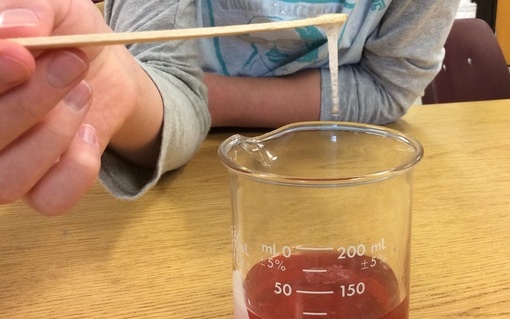
It was fun, relatively simple, and I think hardly any of the students were expecting to actually be able to see the strawberry DNA with their naked eye. Most of them were expecting that you would need to put the solution under a microscope to actually be able to see the DNA.
In addition to working on this experiment, the graduate students all offered their time in a Q&A session, which allowed the Hwa Chong International students the chance to ask any questions they had, whether it was something specific to bioengineering, or whether it was something general about studying in UC Berkeley or even in the United States. All in all, the students had a great time and took away a lot from the interaction session with our gracious hosts.
After a break for lunch, where students had the opportunity to explore some of the favorite lunch spots of Berkeley students, we had the opportunity to walk off all the calories we had just consumed – it was time for the campus tour. There is a lot ot take in at the university, but here are some of the highlights:
Sather Tower
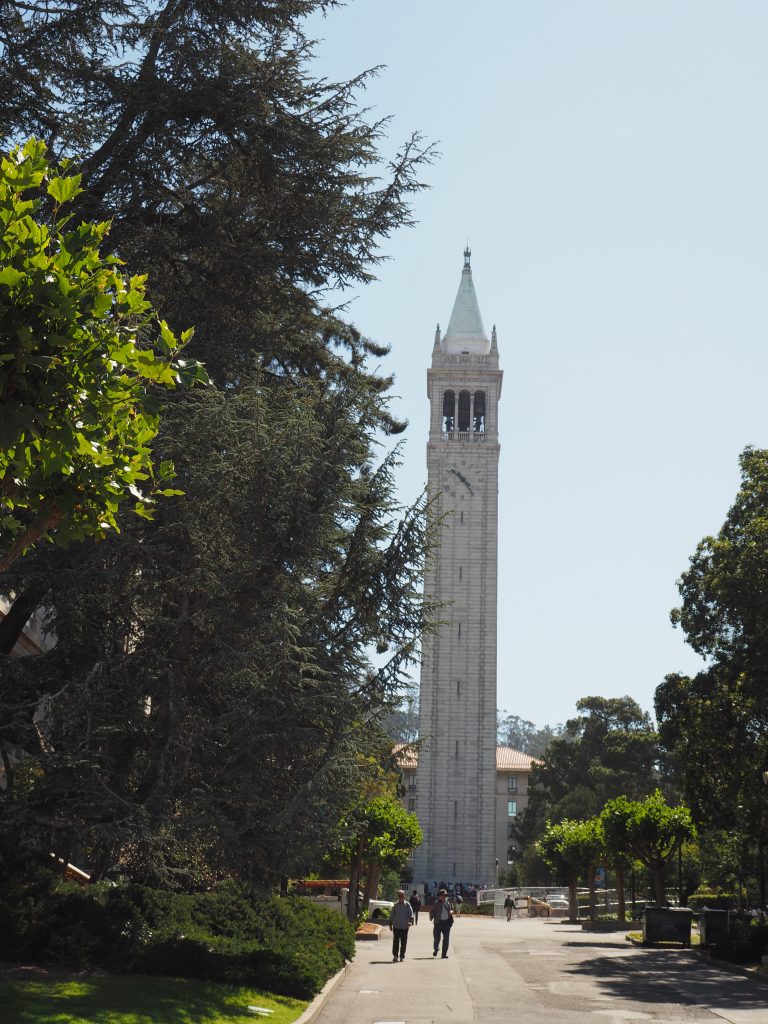
Sather Tower, also known as the Campanile, is the third-tallest bell and clock tower in the world standing at 307 ft. It is also one of the most seismically sound buildings on campus, which is why a lot of dinosaur fossils are stored there as well.
Paleontology Museum
Speaking of fossils, there is a paleontology museum right on campus which features the fossils of a T-Rex and several other prehistoric animals. This is always a crowd favorite, and draws a lot of “oohs” and “aahs” as well as eager shutterbugs.
Faculty Glade
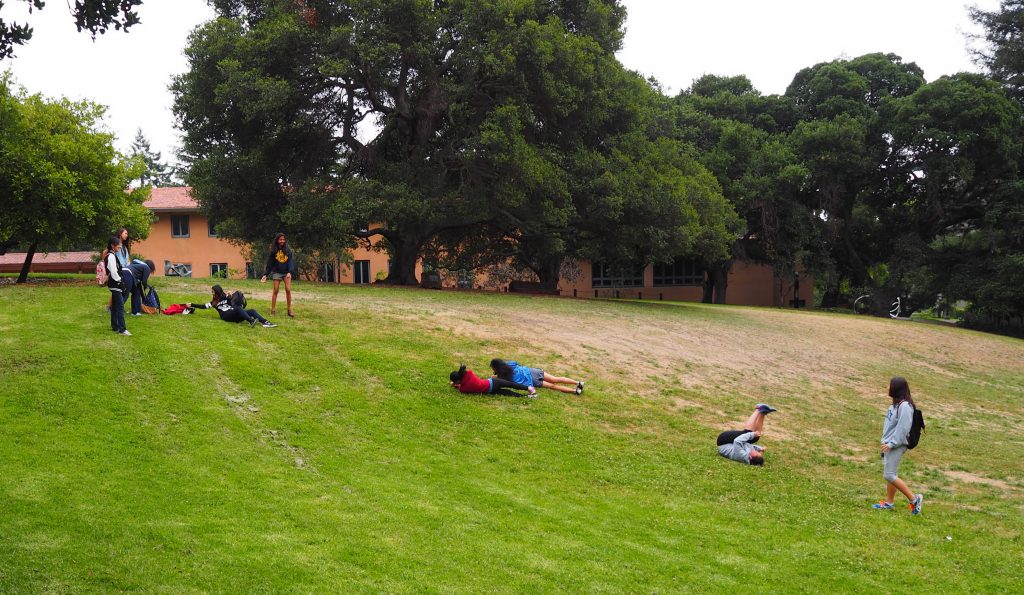
At Berkeley, one of the most famous traditions involves rolling down a hill just outside the faculty club, known as Faculty Glade, in the belief that this will gives students good grades. The legend goes that long ago, students who wanted to petition their professors for better grades would try to get their professors’ attention by standing on the hill and shouting at them while they dined at the faculty club. Most likely, some students who were less careful must have taken a tumble, which is probably what inspired the legend.
On the topic of professors, UC Berkeley is curently home to 7 winners of the Nobel Prize, with many others having worked at the university throughout it’s 150-year history. One of the perks (and tourist attractions) are the parking lots that are reserved for winners of the prestigious prize:

I kid you not. The Berkeley campus is not especially large, and there are only limited parking spaces available on campus. Some professors joke that this special parking pass is even more valuable than the prize itself and the accompanying prize money. When I was a student at UC Berkeley, economics professor George Akerlof won the prize, and when he was presented with a small box as a gift, he commented that this must be his parking pass.
The last stop on our campus tour was the imposing Memorial Stadium, home to the university’s football team. We were given a special behind the scenes tour of the stadium by the athletic department, giving us the rare and unique opportunity to see the stadium from a perspective that even many full-time students at the university do not enjoy:
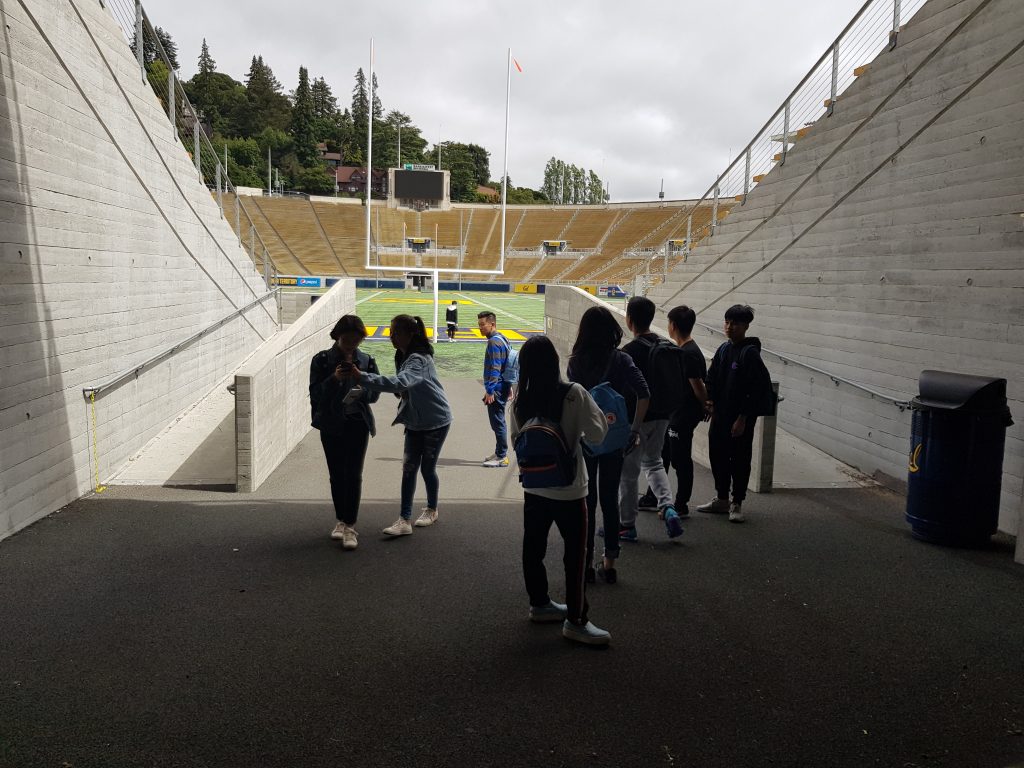
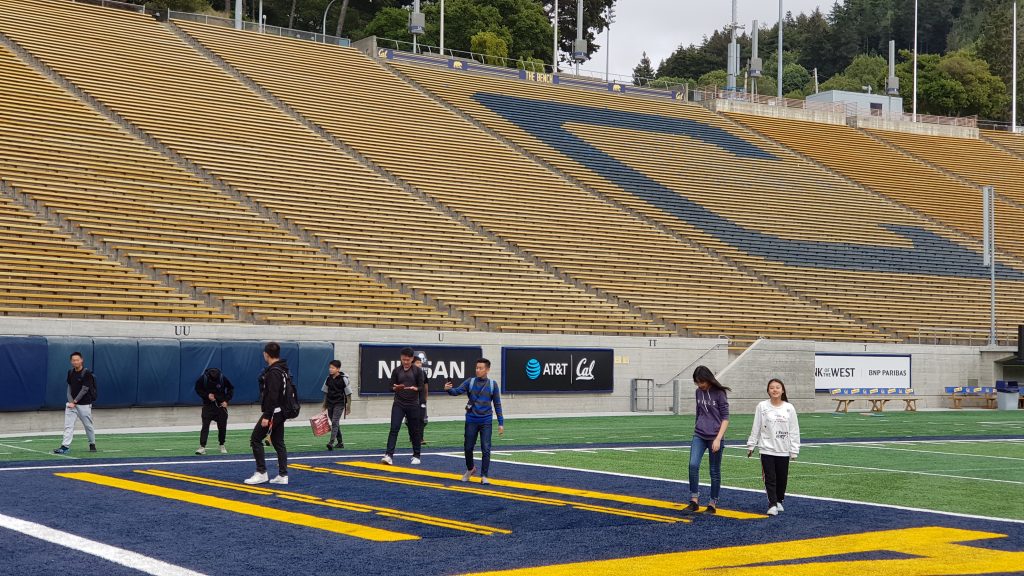
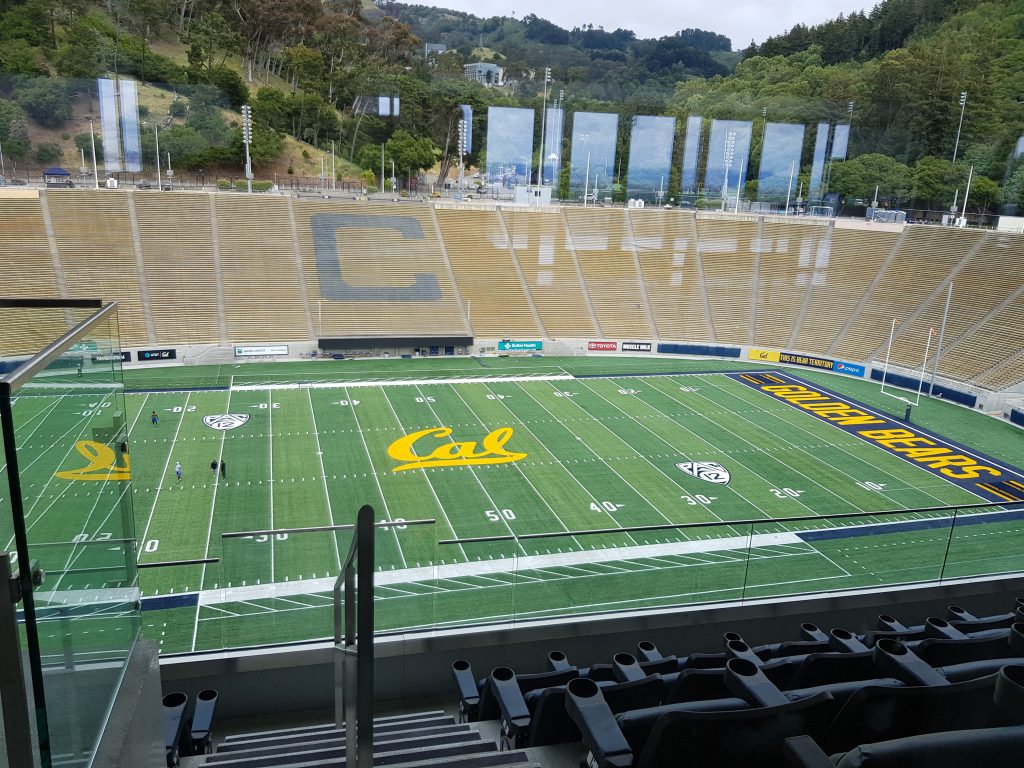
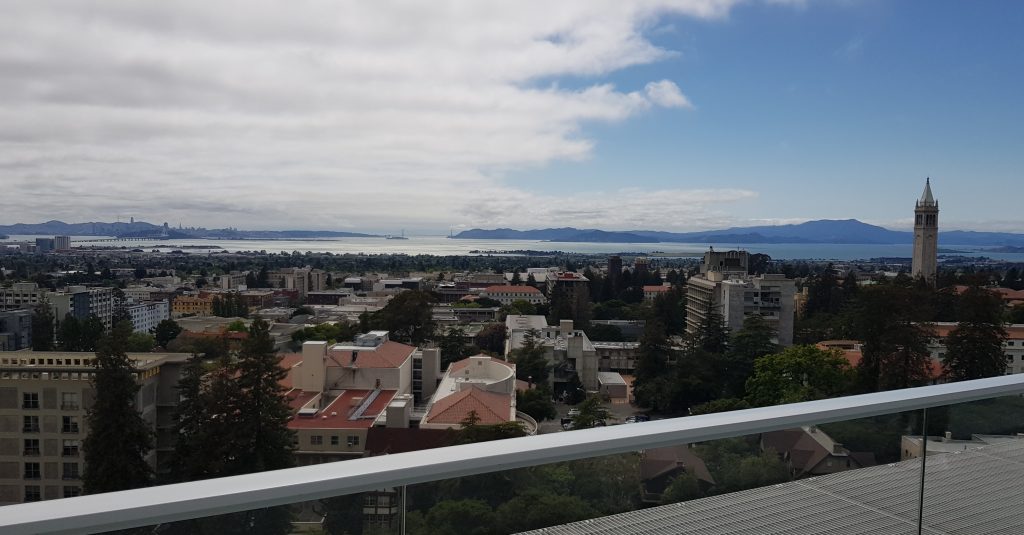
And that concluded our tour and a whirlwind first day. It was now time to get everyone fed and back to the hotel so that they could rest up for the next day’s activities.
Bioengineering Workshops
There is so much to see and do at UC Berkeley, and the university has countless achievements by its students and faculty. However, UC Berkeley is still known first and foremost as one of the top research universities in the world, and the objective of the trip was to let the Hwa Chong International School students experience some of that academic magic. Together with the help of Professor Terry Johnson from the department of bioengineering, we arranged for students from the undergraduate honors society and for graduate students from the graduate student association to prepare two days of workshops for the students.
These workshops gave the students the opportunity to see some of the areas that students of bioengineering study, both as an undergraduate and as a graduate student. We also had Q&A panels with both groups of students, so the students from Hwa Chong International School could ask of them any and all questions that they had about studying in the US in general, at Berkeley in particular or about their prospects in bioengineering. Of course, the main purpose of workshops is to give students the chance to get their hands dirty. They did simple experiments in microfluidics and even built a simple electrocardiogram to measure someone’s heartbeat:
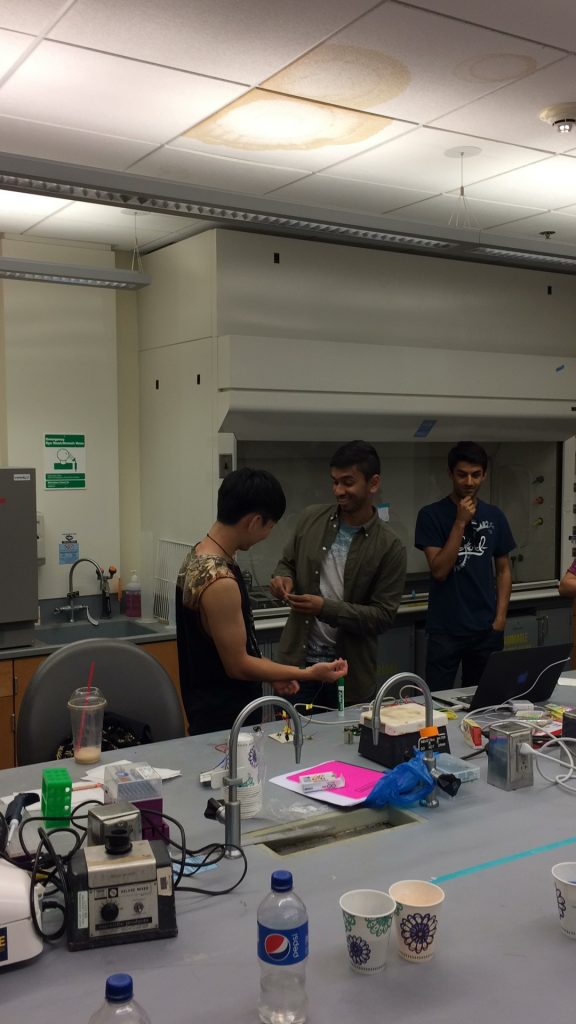
Personally, I feel that this is one of the most valuable aspects of our USA Summer Camps, because it brings to life all the things that students have read about in their textbooks or heard about in lectures. We aim to give students the chance to see and touch all the theory in their books, to see how what they are learning translates into useful real-life applications. This is the best way to get students inspired and fired up about what they are learning.
Of course, what workshop would be complete without some lectures, so we were very fortunate that Professor Terry Johnson himself was available to give us a short lecture. He touched on what Bioengineering really is all about, and what were some of the discoveries that have been made and how they are benefiting mankind. The students found the talk to be extremely interesting as it touched on a topic that they may have only flirted with in school (if they take biology) but would not have studied in great detail.
A Stadium and an Earthquake fault line
If you ever set foot on the UC Berkeley campus, there are a few things that you simply cannot miss by virtue of their size: The Big C, Sather Tower, Evans Hall, just to name a few. But perhaps the biggest structure on campus is the massive Memorial Stadium, which sits over 60,000 people. Since the time when I was a student at UC Berkeley, the stadium has undergone a massive renovation, but it’s not just for vanity’s sake. Memorial Stadium sits on the Hayward fault line, and the renovation was necessary to make the building more seismically sound.
We were really fortunate to be given a behind-the-scenes tour of Memorial Stadium by Assistant Athletic Director, Dave Kao. He was kind enough to bring us down to the field, which is normally only accessible to the student athletes and other staff. Unfortunately, the field was being re-turfed on the day of our visit because there was going to be a new sponsor for the field, so they had to change all the existing logos. Good thing we could still see the Big, Blue C painted on the benches:
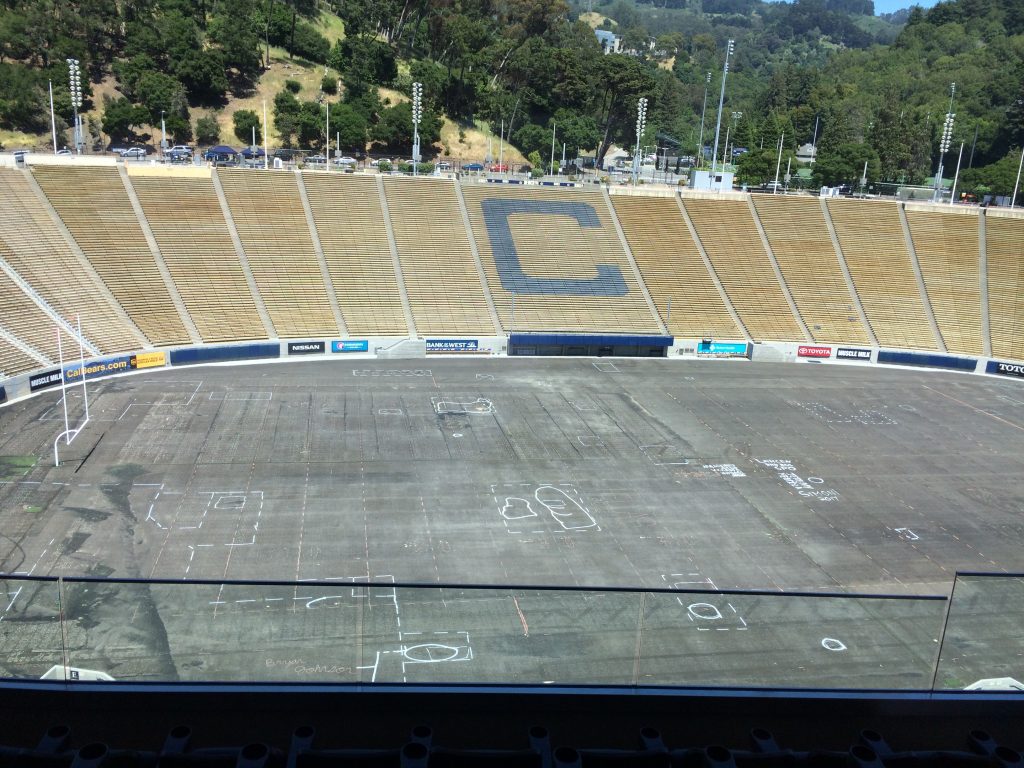
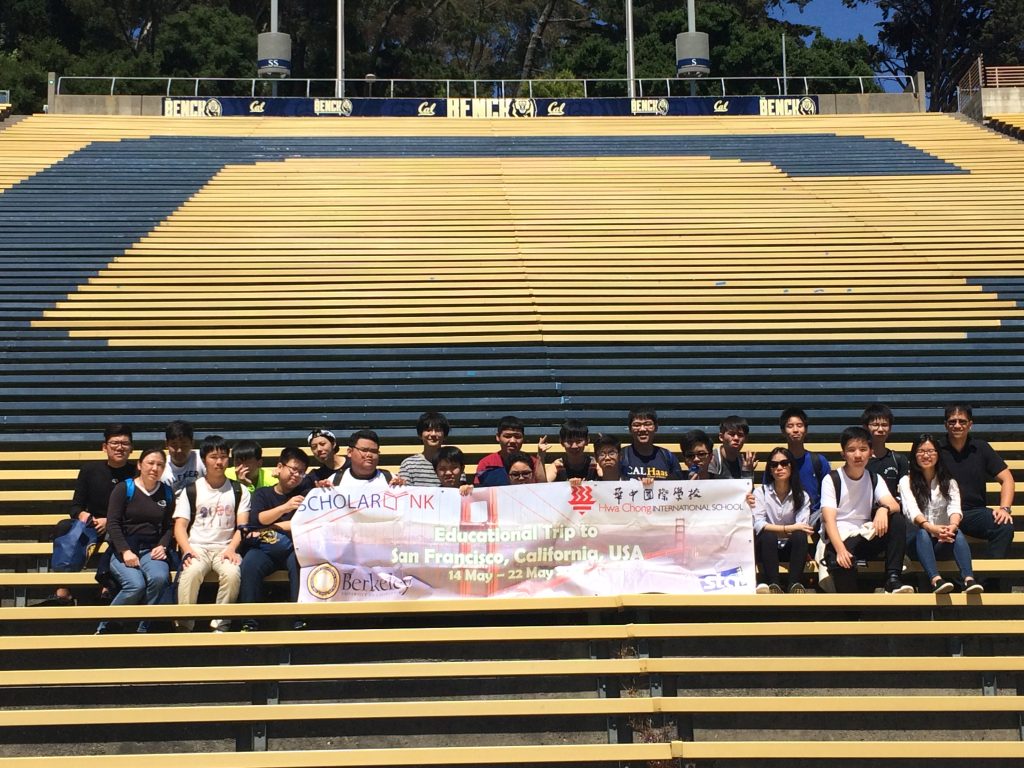
Next, from all the way down on the ground, we were taken all the way up to the private boxes. The view from there is nothing short of magnificent, as the stadium is built on one of the highest points on campus, and is a very tall structure itself. It was a clear spring day when we visited, and you could see out from the balcony all the way across the bay to the city of San Francisco:
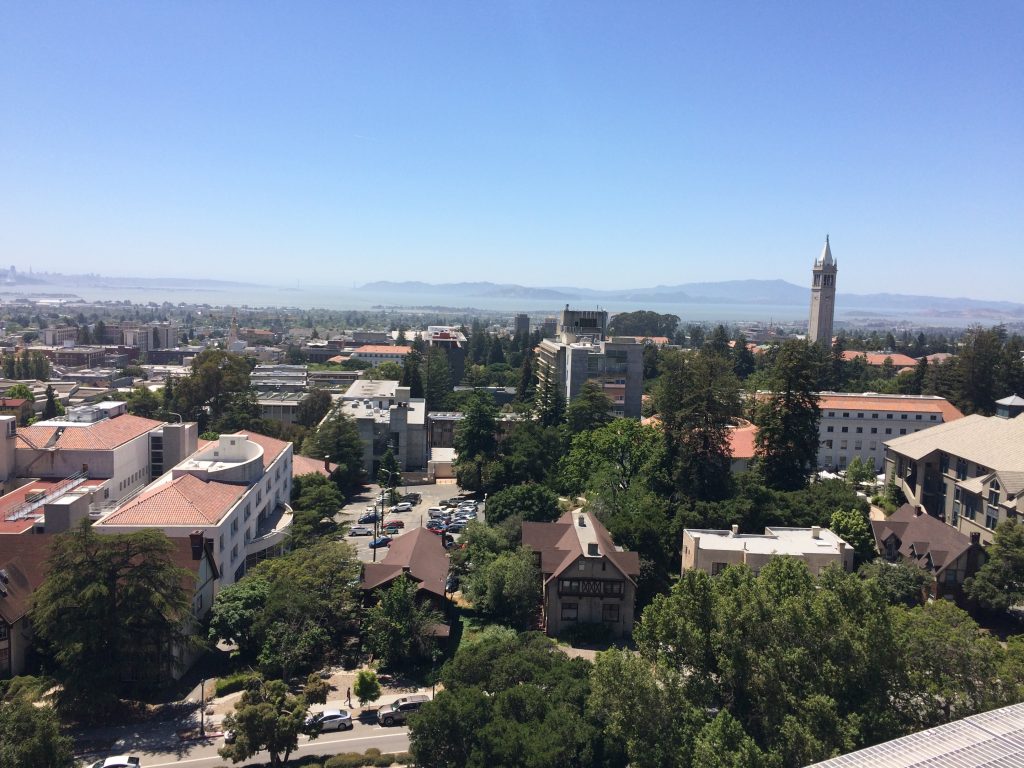
Berkeley has a rich sporting history, with their athletes winning many college titles and many representing the nation in the Olympics (and winning gold) as well. For all these athletes, there is a training gym just for student athletes within Memorial Stadium, and we were allowed to take a quick look and walkthrough:
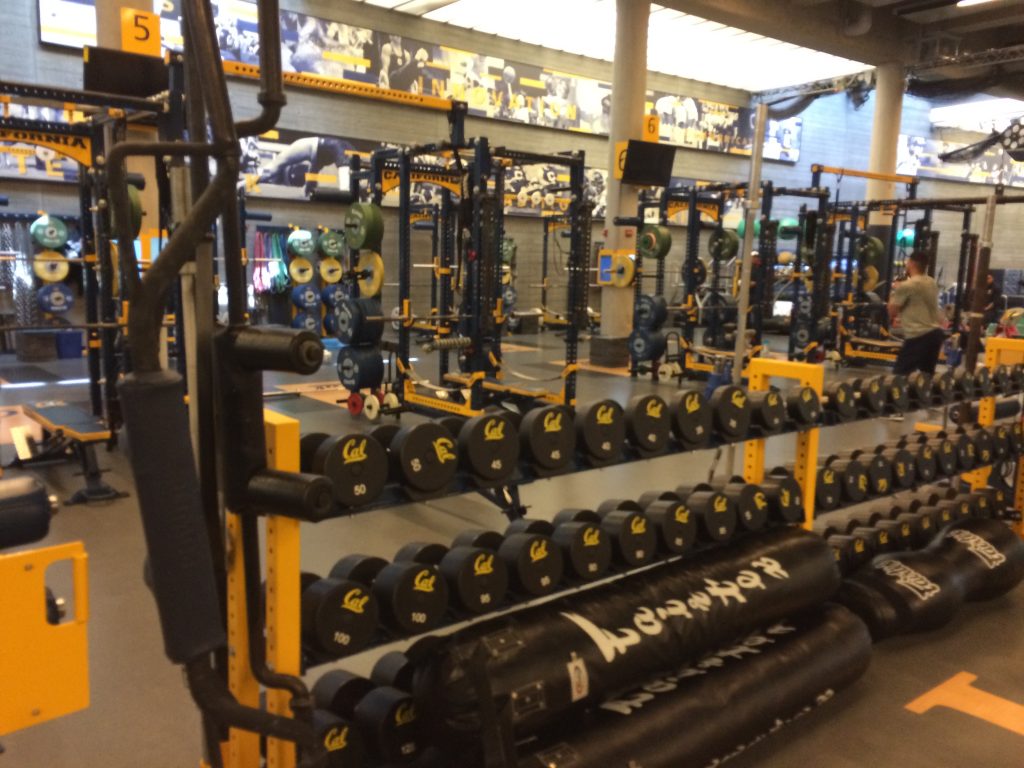
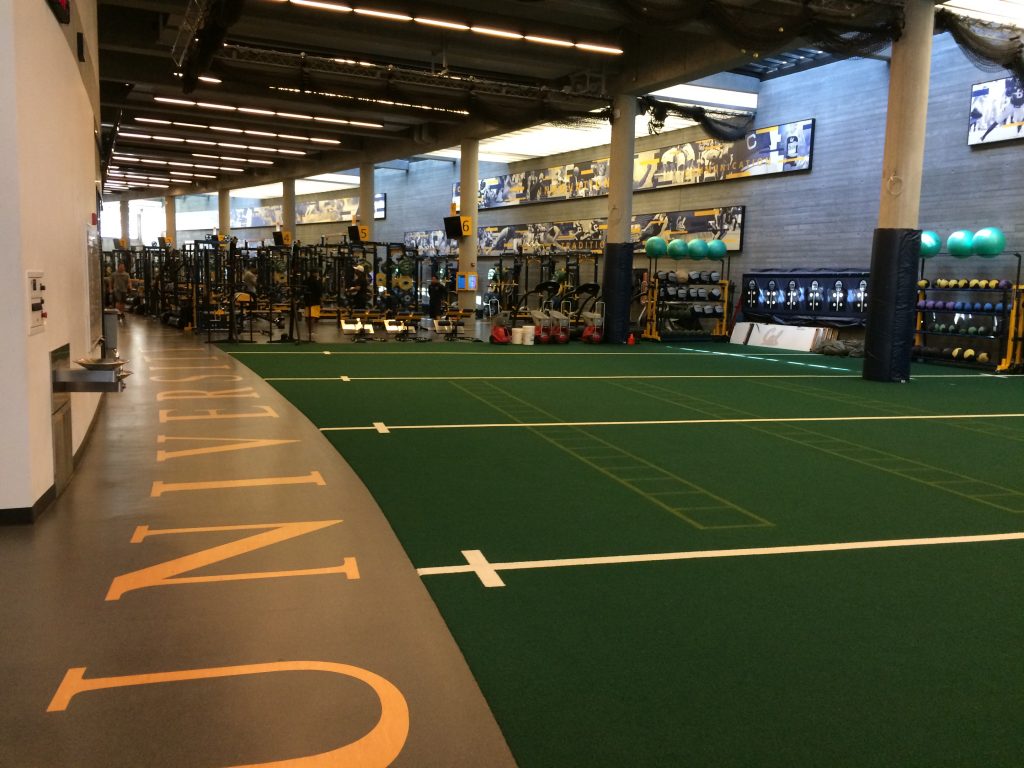
One interesting nugget of information that Dave shared with us, and which was particularly exciting to this group of students who loved basketball: when Kobe Bryant used to play for the Los Angeles Lakers, he would book out the entire gym the night before a match against the Warriors so that he could train with his personal trainer.
Of course, now that we have viewed the home of Cal athletes, we had to go watch a college game, and that’s what we did. We caught a college baseball game the very next day, and it was a good one too, with UC Berkeley emerging victorious!
Visit to Lawrence Berkeley National Laboratory
For this year’s USA Summer Camp, the stars seemed to be aligned just for us, and we managed to secure reservations to a very unique field trip: a visit to Lawrence Berkeley National Laboratories, or Berkeley Lab for short. Berkeley lab is a national lab located right off the main university campus that conducts scientific research on behalf of the United States Department of Energy, and is managed and maintained by the University of California. It was founded by Ernest Lawrence, one of the Nobel Prize winners who served on the university’s faculty, and it bears his name.
The complex is home to 100 buildings on 200 acres of land. Many major scientific breakthroughs have occurred here, including the discovery of 16 elements. We were given a guided tour by on-site research scientists of the Molecular Foundry and the Advanced Light Source.
The Molecular Foundry is one of five nanoscience research centers in the United States, and houses a lot of specialized equipment including an electron microscope:
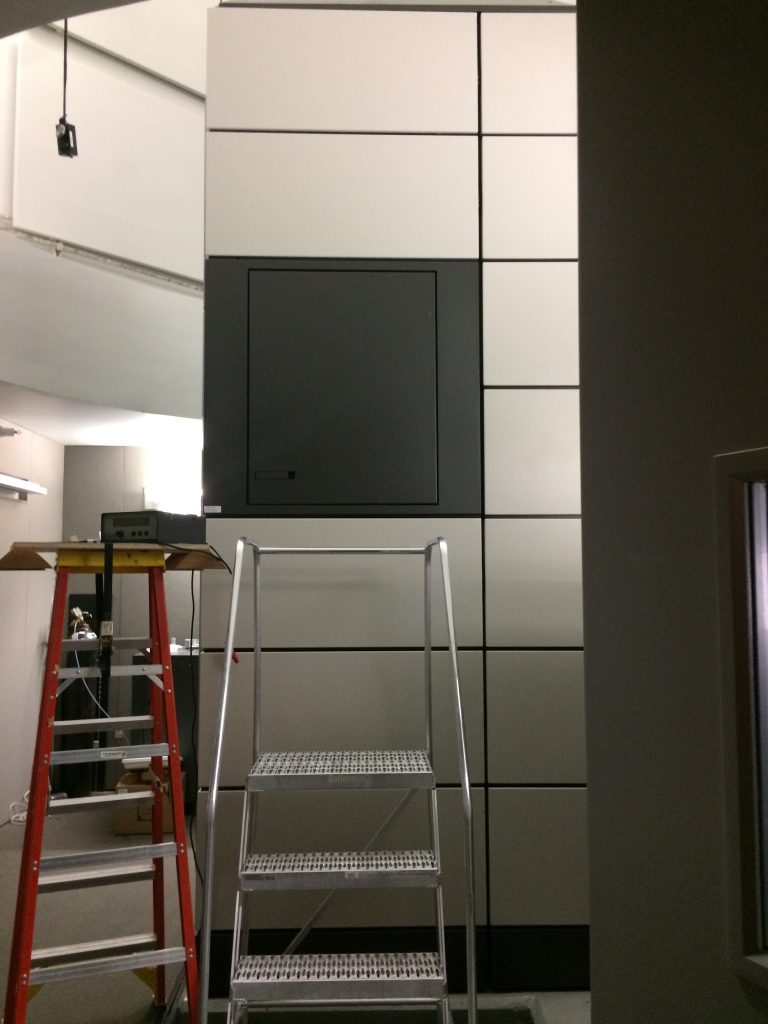
Yeah, I don’t think this was what anyone was expecting when they said we were going to see a microscope that is capable of examining things on the minutest scale. All we got to see was the housing of the electron microscope, and the dark grey panel is a door where you put your sample in to be examined. But, we did get to see some other cool facilities:
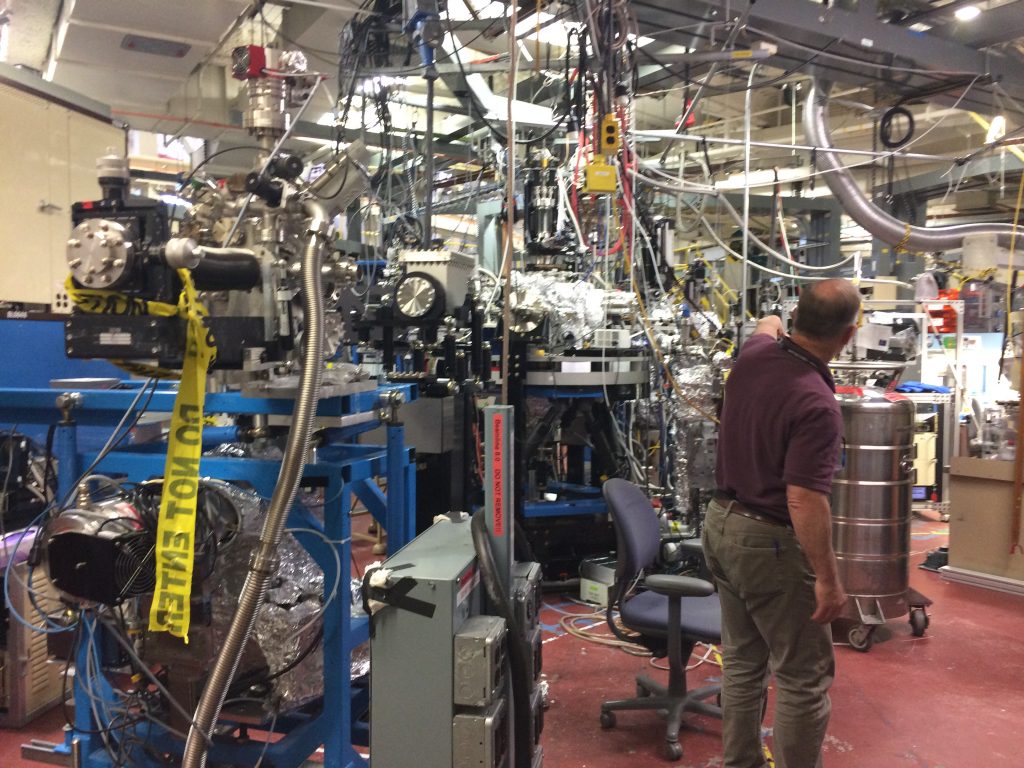
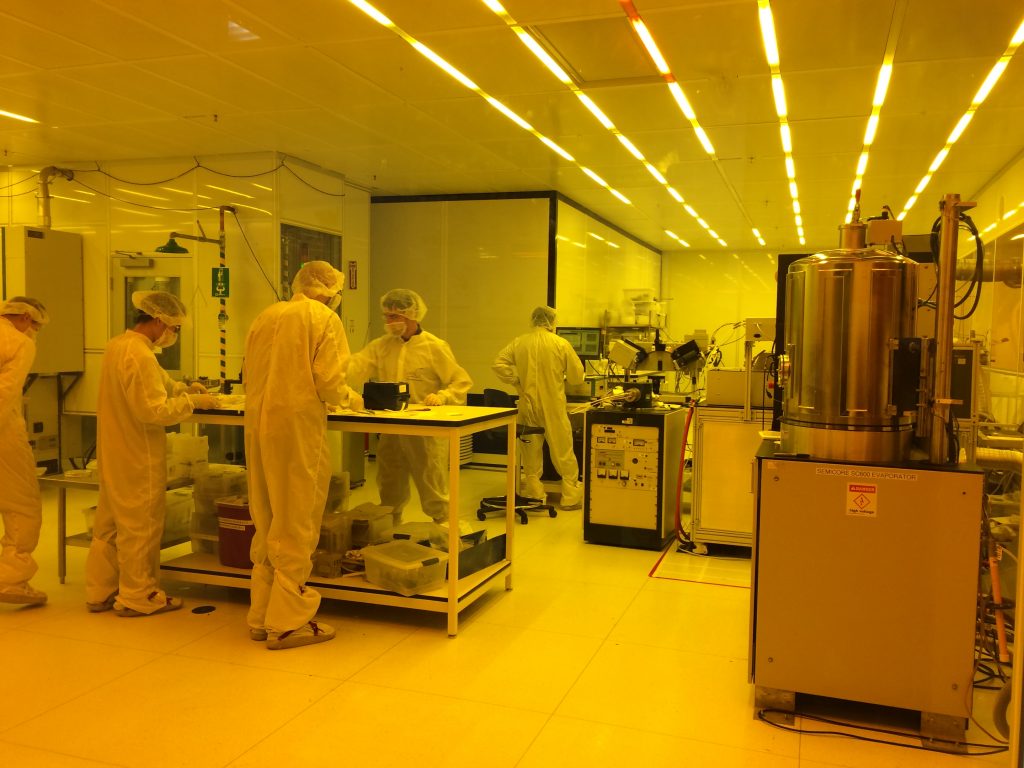
But the main attraction at Berkeley Lab would have to be the domed building at the Advanced Light Source that houses the cyclotron. The cyclotron was the brainchild of Ernest Lawrence, and the original hand-held model is still on display at the nearby Lawrence Hall of Science. It is an accelerator that generates high energy electrons that give of different wavelengths of light as they zoom around the circular ring at near the speed of light. These different wavelengths are harnessed and used for different scientific experiments by researchers who come here from all around the world. Here are some photos of our group inside the domed building and looking down at the cyclotron:
And for all those who are history buffs, there is even an old photo of Ernest Lawrence and other staff members of the cyclotron taken from way back when stuck onto one of the beams right where we were:
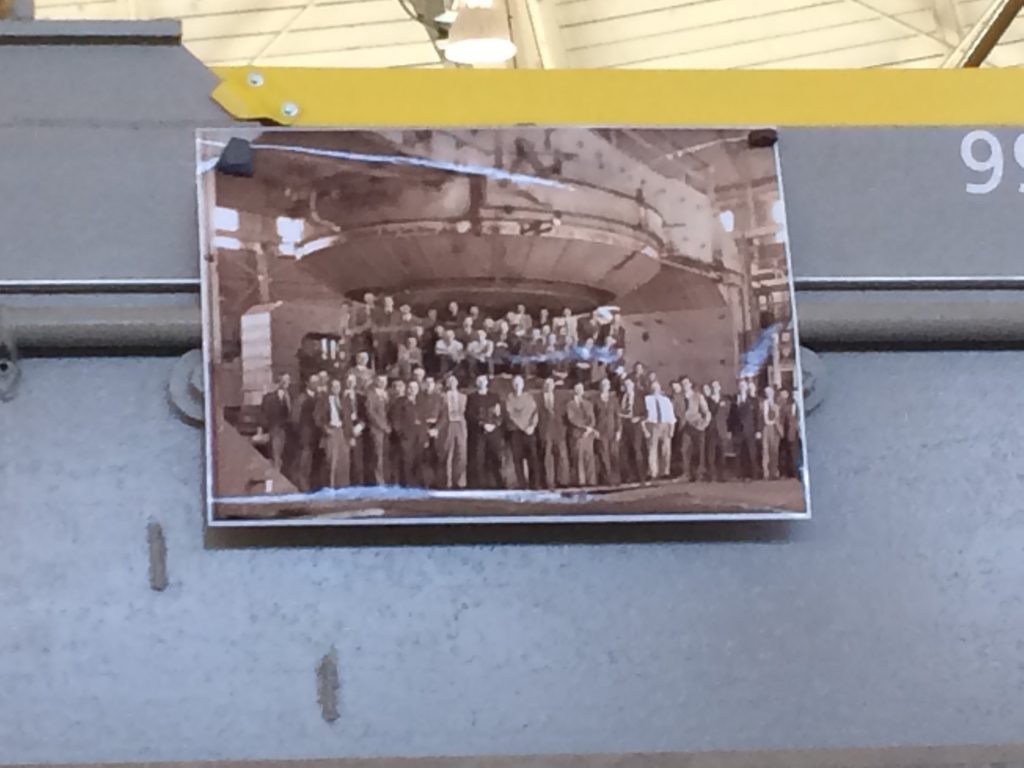
The visit was a very interesting and highly educational one for the students, and it showed them the kind of research that goes on behind the scenes of our retail products. I certainly hope it gave them a greater appreciation of all the things that we are able to enjoy in our world today, and not to take everything for granted.




